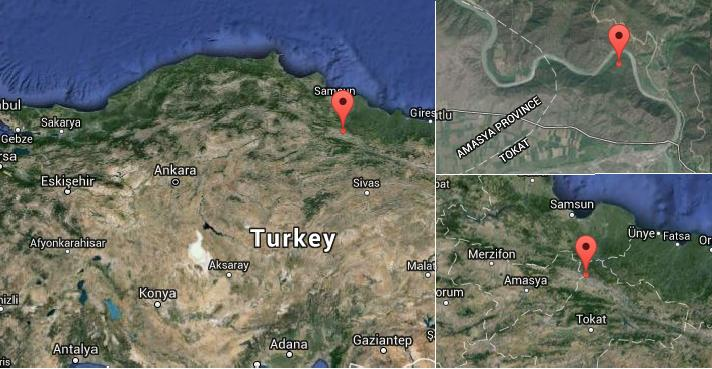Morwenna Ludlow
Do you have a place that you love, that you’ve introduced to a dear friend, only to discover that they absolutely hate it?
This was the subject of the paper I delivered to the North American Patristics Society, whose annual meeting took place this May in Chicago. Basil of Caesarea (c.329-379) is famous as the ‘father of monasticism’, but before setting up his famous monastery in Caesarea he (and his family and friends) experimented with other ways of being a monk. Basil travelled around various ascetic communities on a kind of gap year after university in Athens; he then went and taught rhetoric in Caesarea, but soon had a change of heart and settled on a remote part of his family estate (at Annisa, modern Uluköy) to live as a hermit with a small group of other men.
The point of my paper was the way in which Basil described his ascetic retreat – he’s writing a letter to his friend Gregory of Nazianzus trying to encourage him to join him. Although it was wild and remote, Basil describes his favourite place as a garden (similar in some ways to the garden of Eden). The earth seems to generate fruit without human labour; the river contains countless fish; the land nurtures wild animals and, fortunately, not really wild ones like bears or wolves, but conveniently edible ones like deer, goats and hares. It is a place of fertility and beauty, surrounded by a ‘forest of many-coloured and multifarious trees’. The place is tightly enclosed by the mountain and forest on one side and by the bend of a swiftly-flowing river on the other three. Here, Basil declares, he can find true peace: it is a garden and a sanctuary.
Usually, with the church fathers, we only have one voice and we cannot hear anyone answering back. In this case, however, we have Gregory’s witty but excoriating reply: ‘I tried living there with you, Basil, and it was a hell-hole’, he says (I only re-phrase a little). ‘Far from being a beautiful Eden, it was full of mud, the huts leaked and there was so little to eat that your mother had to rescue us by bringing us supplies from your family home up the road’. It is clear that Gregory hated the place that Basil loved – and that he felt trapped. While Basil reads the landscape as providing safe enclosure, Gregory reads it as entrapping him, constricting the light, even strangling him.
So these two friends interpret the same landscape in two very different ways. Why is this important? First, it becomes clear on a close reading that their disagreement lies in more than Gregory’s disinclination to get cold and wet: his vision of the celibate ascetic life – to which he was equally committed – was that of the gentleman scholar. He objected to Basil’s belief that an ascetic life involved manual labour, especially if that meant working alongside those who had previously been one’s servants or slaves. Gregory wanted independence and free movement from the city to a civilised place of study and back again.
Second, although a lot has been written about asceticism and wilderness, most of this has been about the wilderness of the desert in Egypt and Palestine, not the very different wilderness of the mountains, rivers and forests of Cappadocia. It is true that this wilderness takes on symbolic meaning, just as the desert did – we have seen Basil construe it as an Eden. But my argument is that Basil and Gregory are arguing about a real landscape, not just about what it symbolises. Some scholars think they have found Basil’s retreat; even if we cannot pin-point it precisely it is clear that Basil and Gregory are describing the landscape around the ancient river Iris (modern Yeşil Irmak). Their responses to the landscape are tied up with their beliefs about action – for Basil, manual labour; for Gregory, the ability to contribute to civic life as well as solitary contemplation. In my paper I compare the precision and breadth of Basil’s language for the Cappadocian landscape to the kind of landscape writing studied by Robert Macfarlane in his books, Wild Places and Landmarks. Basil – and Gregory – write about this particular landscape in particular ways, because they act in it in particular (and rather different) ways. Landscape writing, then, is not a disembodied intellectual pursuit; it’s an embodied response to a material environment.

Imagery ©2016 TerraMetrics, Map Data ©2016 Google
Recent studies of ancient Christian asceticism stress the crucial role of embodiment: although some ascetics write in terms of trying to escape the body, most ascetic writing sees a much more fluid relationship between body, soul and mind in which the body is a crucial site for ascetic practice. (There’s some fantastic writing on fasting, for example.) But if bodies are crucial, so are their material locations – and much less has been made of this. Basil’s and Gregory’s argument about that place on the bend of the river Iris makes the connection between spiritual development, embodied action and the materiality of a place in a unique and provocative way. But theirs is just one response: in the workshop that I convened, we also had papers on Clement of Alexandria, Augustine, Gregory of Nyssa and John Chrysostom.
